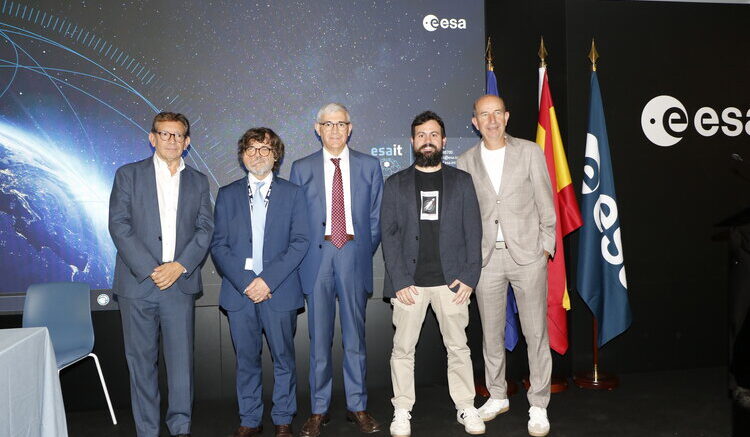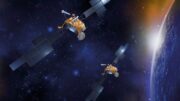ESA drives growth in Spanish positioning and timing industry with NAVISP
Following a call by the European Space Agency (ESA), nine projects have been selected in close coordination with the Spanish Space Agency (AEE) for funding under ESA’s Navigation Innovation and Support Program (NAVISP). This initiative strengthens Spain’s industrial competitiveness in positioning, navigation and timing (PNT) with the development of new products and services and strengthens the country’s presence in the global space market.
In the context of ESA’s 50th anniversary celebration on 16 October 2025 at the European Space Astronomy Centre (ESAC), ESA has signed 9 contracts with Spanish companies to support industry in developing new PNT products and services across sectors, from rocket launchers and automotive to critical infrastructure monitoring and cybersecurity.
The activities have a total value of over €10 million, with ESA co-funding half of the budget and industries contributing the remaining. These investments reflect ESA’s commitment to driving innovation and competitiveness through partnering with industry to shape the future of navigation.
Developing homegrown PNT technologies reduces reliance on external suppliers and strengthens Europe’s strategic autonomy. Moreover, this move also opens the door for Spanish firms, already at the forefront of satellite navigation and alternative PNT technologies, to expand in high-value global markets.
The projects have been selected from a pool of proposals following a call by ESA and the AEE earlier this year under ESA’s NAVISP Element 2. “This Element is aimed at increasing the competitiveness of the PNT industry by supporting the development of products ready for commercial use. We facilitate industries’ entry to the market by sharing risks,” explains ESA’s Head of NAVISP Rafael Lucas.
“The Spanish Space Agency made a great effort last year by launching a call for proposals for ESA’s NAVISP programme. This collaboration has had an excellent impact on participants, both in terms of a solid technical evaluation and a significant reduction of the time-to-contract,” says AEE’s Director of Programmes and Industry, Cecilia Hernández Rodríguez. “The excellent outcome of this NAVISP call for proposals reinforces the Spanish strategy for the 2025 Ministerial Conference in the field of PNT and FutureNAV. Spain holds an international leadership position in satellite navigation.”
Spain has supported NAVISP since its creation in 2016 and is one of the largest contributors.
“Both the Spanish Space Agency and the country’s industrial sector play a key role in preparing the future of European PNT, with a notable part in ESA’s FutureNAV programme. This is exemplified by Spanish industries being awarded the prime contract for one of the two Celeste (LEO-PNT) families that will form the low Earth orbit demonstration constellation, with the first launch scheduled in the coming months,” states ESA Director of Navigation Javier Benedicto.
The projects
The nine contracts signed support Spanish companies across a diversity of sectors and are expected to lead to scalable solutions, new business models and follow-on investments.
- GMV Aerospace and Defence, through the project ENIGMA,will enhance their GNSS high-accuracy positioning solution using Artificial Intelligence techniques to model ionospheric interference and detect jamming and spoofing. The current version of this solution is already used by automotive, farming and industrial robotics industries.
- The same company has also signed a contract to develop DRESS, a next-generation of their satellite-based augmentation system (SBAS) ground reference station receiver. This updated receiver, dual-frequency and multi-constellation, will support new SBAS programmes like the Australian SouthPAN.
- SatelIoT intends to enable Internet-of-Things devices to position themselves and synchronise their time without the use of power-hungry GNSS receivers. This will be achieved by using their 5G communications constellation, under the project FreeGNSS.
- Sener Aeroespacial will develop an evolution of their current navigation unit NAVIGA, originally developed for VEGA-C launcher to incorporate new capabilities for mission scenarios such as kick-stage, in-orbit servicing, beyond low Earth orbit operations and Earth re-entry.
- Inster Tecnología y Comunicaciones proposes a new product for guidance, navigation and control of drones of between 40 and 600 kg using communication signals from low Earth orbit to complement or back-up satellite navigation signals.
- PLD Space aims to develop HALCON (Hybridisation Algorithms and Low-cost Components for Optimised Navigation), a navigation system that combines satellite navigation with inertial measurement units to guide the upcoming MIURA-5 European reusable launcher.
- Indra Deimos will develop a system for satellites in low Earth orbit that require real-time orbit determination and time synchronisation.
- Pildo Labs has signed a contract to enhance their satellite navigation monitoring software, called The OWL, for airport operations. It will support dual-frequency multi-constellation performance monitoring and carry out interference detection and localisation for air navigation operators.
- INTEGRASYS will develop NAVSHIELD, an advanced positioning, navigation and timing protection system against accidental or intentional interference for critical infrastructure.
About NAVISP
ESA’s Navigation Innovation and Support Programme (NAVISP) aims to cultivate European and Canadian industrial capacities while pioneering the advancement of novel positioning, navigation and timing (PNT) systems. The programme fosters innovation beyond satellite navigation, spearheading the development of products and services to use, back-up, complement or augment existing PNT capabilities.
By mitigating commercial R&D risks and facilitating the development of new products and services, NAVISP enhances global market access for European industry and strengthens national capabilities.
NAVISP was created in 2016 as an optional ESA programme and is supported by 20 states.
Source: ESA







Be the first to comment on "with NAVISP, ESA drives growth in Spanish positioning"